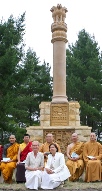By Neena Bhandari
Sydney, 21.11.2008 (IANS): It has been hailed as historic. A five-metre-high Ashoka Pillar now stands at a monastery located midway between Sydney and Canberra, in a celebration of the spread of Buddhism from India to Australia.
Believed to be the first in Australia, the Ashoka Pillar has been installed at the Sunnataram Forest Monastery in the verdant surroundings of Southern Highlands.
“This is a truly historic event. The Ashoka Pillar, whose Lion Capitol is the national emblem of India, symbolises the global relevance of the principles of truth, non-violence, tolerance and compassion,” Sujan R. Chinoy, consul general of India in Sydney, told IANS.
“Emperor Ashoka fostered democratic rule and it is a privilege to dedicate the Ashoka Pillar at a Buddhist monastery in a fellow democracy such as Australia.”
 The pillar stands on a pagoda next to a topographical world map showing the spread of Buddhism – one of the fastest growing religions in Australia.
The pillar stands on a pagoda next to a topographical world map showing the spread of Buddhism – one of the fastest growing religions in Australia.
Facing the breathtaking views of the mountainous Kangaroo Valley on one side and the vast expanse of the ocean on the other, the Sunnataram Forest Monastery attracts hundreds of people of all nationalities, especially on weekends, for meditation, relaxation and healing.
It was during a pilgrimage to India last year that the head monk of the monastery, Phra Mana Viriyarampo, decided to construct an Ashoka Pillar in Australia. The monastery is dotted with carved sandstone “Life of the Buddha” panels, copied from the Sanchi Stupa in India, on display in the garden and under trees.
The Ashoka Pillar has been hand-carved by artists in Thailand and the sandstone supporting base has been constructed by monks and volunteers of the monastery.
“This is to express our gratitude to Emperor Ashoka for his foresight in preserving and spreading the teachings of the Buddha to different parts of the world. It has made it possible for us to practise the teachings of the Buddha in Australia today,” says Kim McSweeney, secretary of the monastery.
She is also chairperson of the Gratitude Pagoda Project, which includes the world map and a museum.
“The world map will be expanded to depict the life of the Buddha and how his teachings have been adopted and adapted in many cultures, influencing the way of life and art in those countries,” McSweeney told IANS.
According to the 2006 census, there were 418,755 Buddhists comprising 8.9 percent of the total population. Between 1996 and 2001, the number of people affiliated with Buddhism increased by 79 percent, reflecting the growth in migrants from India and other parts of Asia.
About a thousand people, including Indians, Sri Lankan, Thai, Laotian, Vietnamese, Cambodian, Chinese, Singaporean, Malaysian, Burmese and Australians, attended the weekend installation ceremony.
© Copyright Neena Bhandari. All rights reserved. Republication, copying or using information from neenabhandari.com content is expressly prohibited without the permission of the writer and the media outlet syndicating or publishing the article.

